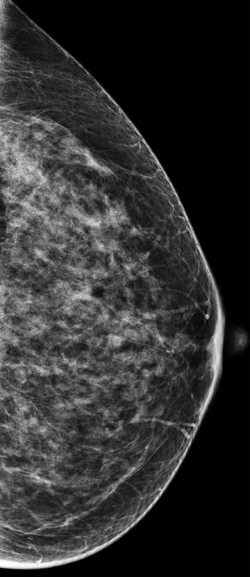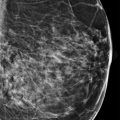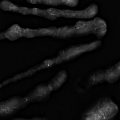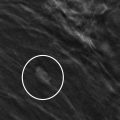Presentation and Presenting Images
A 44-year-old female with a history of right breast cancer treated 3 years ago presents for screening mammography.
35.2 Key Images
35.2.1 Breast Tissue Density
The breasts are heterogeneously dense, which may obscure small masses.
35.2.2 Imaging Findings
In the superior aspect of the left breast, there is an area of architectural distortion that is seen on the mediolateral oblique (MLO) view ( ▶ Fig. 35.3) and best seen on the MLO digital breast tomosynthesis (DBT) slice 30 of 58 ( ▶ Fig. 35.4). Therefore this area of architectural distortion should be around the 11 to 12 o’clock location. No definitive correlate can be seen on the craniocaudal (CC) view ( ▶ Fig. 35.5).
35.3 BI-RADS Classification and Action
Category 0: Mammography: Incomplete. Need additional imaging evaluation and/or prior mammograms for comparison.
35.4 Diagnostic Images
( ▶ Fig. 35.5, ▶ Fig. 35.6, ▶ Fig. 35.7, ▶ Fig. 35.8, ▶ Fig. 35.9, ▶ Fig. 35.10, ▶ Fig. 35.11, ▶ Fig. 35.12, ▶ Fig. 35.13)
35.4.1 Imaging Findings
The diagnostic imaging demonstrates persistent architectural distortion in the upper half of the left breast. The repeat CC view did not reveal any correlate to this ( ▶ Fig. 35.5). Based on the information from the DBT imaging performed at screening, the ultrasound was directed to the 11 to 12 o’clock location. At the 11 o’clock location, 4 cm from the nipple, there is a mass with indistinct margins and posterior acoustic shadowing ( ▶ Fig. 35.10 and ▶ Fig. 35.11). This lesion was referred for biopsy. The images demonstrate a ribbon clip placed at the site of the biopsy performed by ultrasound ( ▶ Fig. 35.12 and ▶ Fig. 35.13).
35.5 BI-RADS Classification and Action
Category 4B: Moderate suspicion for malignancy
35.6 Differential Diagnosis
Radial scar: The mammographic and sonographic features are consistent with the diagnosis of a radial scar, which can mimic cancer.
Breast cancer: Architectural distortion has a high probability of cancer when identified mammographically.
Sclerosing adenosis: Architectural distortion is one of the three presenting features of sclerosing adenosis.,with the other two being a mass and calcifications. If the biopsy was largely composed of sclerosing adenosis in proportion to the size of the imaging finding, and not just an incidental finding, it could be considered a concordant diagnosis.
35.7 Essential Facts
A radial scar and complex sclerosing lesion are similar. A complex sclerosing lesion is larger than a radial scar (> 1 cm) and has more proliferative tissue.
Most radial scars are asymptomatic.
Radial scars are mostly identified at screening mammography or as an incidental finding on biopsy for another reason.
Radial scars on mammography present as distortion with long thin spicules emanating from a central region without a “mass.”
On ultrasound, radial scars are commonly irregular hypoechoic masses with posterior shadowing.
35.8 Management and Digital Breast Tomosynthesis Principles
Radial scars mimic cancer on mammography and ultrasound, and thus warrant a biopsy.
Architectural distortion when present on mammography represents cancer in 75% of cases.
A radial scar or a complex sclerosing lesion are the most common nonmalignant pathologic findings of architectural distortion.
Architectural distortion without an ultrasound correlate has only a 30% chance of being cancer according to the study by Bahl and colleagues (2015). This 30% risk is too high to avert a biopsy.
35.9 Further Reading
[1] Bahl M, Baker JA, Kinsey EN, Ghate SV. Architectural Distortion on Mammography: Correlation With Pathologic Outcomes and Predictors of Malignancy. AJR Am J Roentgenol. 2015; 205(6): 1339‐1345 PubMed
[2] Shaheen R, Schimmelpenninck CA, Stoddart L, Raymond H, Slanetz PJ. Spectrum of diseases presenting as architectural distortion on mammography: multimodality radiologic imaging with pathologic correlation. Semin Ultrasound CT MR. 2011; 32(4): 351‐362 PubMed

Fig. 35.1 Left craniocaudal (LCC) mammogram.
Stay updated, free articles. Join our Telegram channel

Full access? Get Clinical Tree








